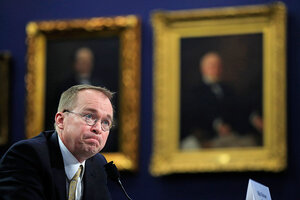Dodd-Frank 'rollback'? What bipartisan easing of bank rules could mean.

Office of Management and Budget Director Mick Mulvaney testifies before a House Appropriations Committee hearing on Capitol Hill in Washington. As acting director of the Consumer Financial Protection Bureau, created by the 2010 Dodd-Frank Act, he has argued for greater restraint by financial regulators. The agency will survive under a reform of Dodd-Frank that passed the House Tuesday.
Manuel Balce Ceneta/AP/File
Washington and Boston
Congressional action to ease US bank regulation may prove both its fans and critics right. It may achieve its goal of helping smaller banks even as it also weakens oversight of America’s overall financial system.
Translation: Loans may flow a bit more freely, and small and midsize banks may soon be able to better compete against larger ones. But as the new measure erodes provisions in the 2010 Dodd-Frank Act, it could also heighten the risk of a financial crisis in the future.
It’s notable that the banking bill won some Democratic as well as Republican support as it passed the House Tuesday and the Senate in March, even though it dials back regulatory safeguards that President Obama pushed in the wake of the 2008 financial crisis. Even some supporters of the law agreed with arguments by the bank industry that Dodd-Frank was too onerous for smaller banks. President Trump is expected to sign the measure soon.
Why We Wrote This
Banks are a fulcrum of the economy, either fueling growth or sometimes stifling it when their condition turns sour. So it's worth a closer look when some Democrats join Republicans to ease their regulatory boundaries.
Some analysts say they expect the benefits of the reform will outweigh the costs, because the bill leaves the wider structure of US financial regulation largely intact.
“It'll be a while before you see the difference, but it should free up lending at small and midsize banks as well as credit unions that previously had been hemmed in by regulatory and compliance overhead,” says Greg McBride, who analyzes financial conditions at Bankrate.com.
Nevertheless, the loosening of restraints on lending for small and midsize banks won’t necessarily lead to a flood of new borrowing, economists point out.
“Yes we’re doing that [loosening] on the regulatory front, but it’s also coming at a time when the Fed is tightening, credit conditions are in general tighter, and the [business] cycle by most accounts is fairly mature,” says Michael Gapen, chief US economist for Barclays in New York. The big exception is home mortgages, where interest rates are rising, but lending standards have not tightened, he adds.
That doesn’t mean the banks will have to cope with an immediate downturn, he adds. For at least the next 12 months, the double-barreled stimulus from the Trump tax cuts and the recently passed federal budget should buoy the economy.
The US still has some 5,000 commercial banks, plus many credit unions, but the trend in recent years has been toward mergers and consolidation, as lenders seek economies of scale. One reason is the rising cost of regulation since 2010.
“I've seen small banks that have 10 to 15 percent of their staff devoted solely to compliance,” says Mr. McBride at Bankrate. That makes it hard to compete with bigger banks, which can spread their compliance costs over a much bigger base of business.
One example of how the new law may free up more lending: The bill loosens an "ability-to-repay" rule for mortgage loans issued by small banks, if the loans are retained on a lender's books (rather than sold after issuance to an agency like Fannie Mae). [Editor's note: The prior sentence has been updated to reflect that the rule change relates to mortgages made by small banks.]
“That's music in the ears of somebody that's, for example, a sole proprietor and has wildly fluctuating income” from that business. For such borrowers “it's been very difficult to get a loan” since the Great Recession and Dodd-Frank, says McBride.
Still, core provisions of the bill (officially called the Economic Growth, Regulatory Relief, and Consumer Protection Act) worry some experts on financial regulation.
Most notable: Enhanced regulatory standards will now apply to banks with $250 billion or more in assets, rather than $50 billion. That, says Gregg Gelzinis of the liberal Center for American Progress, means that 25 of the 38 largest US banks will no longer have to maintain as much capital on hand as a cushion against risk, or create “living wills” – plans for how to unwind themselves in a potential collapse.
Even without further reforms of Dodd-Frank, conservatives are pushing against regulations from the agency that Dodd-Frank created, the Consumer Financial Protection Bureau. On Monday, Mr. Trump signed into law a repeal of the CFPB’s moves to mitigate racial discrimination in auto loans. (Republicans point out that the agency ducked the formal rulemaking process to push through its guidance to lenders.)
Also, the agency under Trump appointee Mick Mulvaney appears to be pulling back from overseeing institutions making and servicing student loans. In a letter Friday, Senate Democrats asked Mr. Mulvaney to explain how the agency would fulfill its statutory obligations.
Another target for conservatives is the CFPB’s stiff regulation of payday lenders, who have sued the agency for relief. Mulvaney has not made clear whether he will contest the suit.
In the end, the action in Congress showed the ability of Senate Democrats to block the more sweeping Dodd-Frank rollback that Republicans, especially in the House, were seeking. It also showed the capacity for bipartisan cooperation at a time of stark political divisions.
“Working with Republicans and Democrats, we wrote this bill to defend Montana businesses from overreaching government regulations,” said Sen. Jon Tester (D) of Montana, who played a central role in negotiating the bill. He said the goal was “to boost access to the capital needed to fuel our small business economy, and to create more jobs.”

